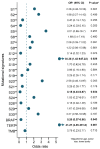APOBEC SBS13 Mutational Signature-A Novel Predictor of Radioactive Iodine Refractory Papillary Thyroid Carcinoma
- PMID: 35326735
- PMCID: PMC8946015
- DOI: 10.3390/cancers14061584
APOBEC SBS13 Mutational Signature-A Novel Predictor of Radioactive Iodine Refractory Papillary Thyroid Carcinoma
Abstract
Standard surgery followed by radioactive iodine (131I, RAI) therapy are not curative for 5−20% of papillary thyroid carcinoma (PTC) patients with RAI refractory disease. Early predictors indicating therapeutic response to RAI therapy in PTC are yet to be elucidated. Whole-exome sequencing was performed (at median depth 198x) on 66 RAI-refractory and 92 RAI-avid PTCs with patient-matched germline. RAI-refractory tumors were significantly associated with distinct aggressive clinicopathological features, including positive surgical margins (p = 0.016) and the presence of lymph node metastases at primary diagnosis (p = 0.012); higher nonsilent tumor mutation burden (p = 0.011); TERT promoter (TERTp) mutation (p < 0.0001); and the enrichment of the APOBEC-related single-base substitution (SBS) COSMIC mutational signatures 2 (p = 0.030) and 13 (p < 0.001). Notably, SBS13 (odds ratio [OR] 30.4, 95% confidence intervals [CI] 1.43−647.22) and TERTp mutation (OR 41.3, 95% CI 4.35−391.60) were revealed to be independent predictors of RAI refractoriness in PTC (p = 0.029 and 0.001, respectively). Although SBS13 and TERTp mutations alone highly predicted RAI refractoriness, when combined, they significantly increased the likelihood of predicting RAI refractoriness in PTC. This study highlights the APOBEC SBS13 mutational signature as a novel independent predictor of RAI refractoriness in a distinct subgroup of PTC.
Keywords: APOBEC-related mutations; COSMIC mutational signatures; SBS13; papillary thyroid cancer; radioactive iodine refractory.
Conflict of interest statement
The authors declare no conflict of interest. The funders had no role in the design of the study; in the collection, analyses, or interpretation of data; in the writing of the manuscript, or in the decision to publish the results.
Figures



Similar articles
-
Non-Iodine-Avid Disease Is Highly Prevalent in Distant Metastatic Differentiated Thyroid Cancer With Papillary Histology.J Clin Endocrinol Metab. 2022 Jul 14;107(8):e3206-e3216. doi: 10.1210/clinem/dgac305. J Clin Endocrinol Metab. 2022. PMID: 35556126 Free PMC article.
-
The molecular and gene/miRNA expression profiles of radioiodine resistant papillary thyroid cancer.J Exp Clin Cancer Res. 2020 Nov 16;39(1):245. doi: 10.1186/s13046-020-01757-x. J Exp Clin Cancer Res. 2020. PMID: 33198784 Free PMC article.
-
TIMING OF RADIOACTIVE IODINE THERAPY DOES NOT IMPACT OVERALL SURVIVAL IN HIGH-RISK PAPILLARY THYROID CARCINOMA.Endocr Pract. 2016 Jul;22(7):822-31. doi: 10.4158/EP151088.OR. Epub 2016 Mar 28. Endocr Pract. 2016. PMID: 27018620
-
PANCREAS METASTASES FROM PAPILLARY THYROID CARCINOMA: A REVIEW OF THE LITERATURE.Endocr Pract. 2017 Dec;23(12):1425-1429. doi: 10.4158/EP-2017-0001. Epub 2017 Nov 16. Endocr Pract. 2017. PMID: 29144798 Review.
-
Papillary thyroid carcinoma tall cell variant.Thyroid. 2008 Nov;18(11):1179-81. doi: 10.1089/thy.2008.0164. Thyroid. 2008. PMID: 18925842 Review.
Cited by
-
Advances in transcriptomics and proteomics in differentiated thyroid cancer: An updated perspective (Review).Oncol Lett. 2023 Jul 27;26(3):396. doi: 10.3892/ol.2023.13982. eCollection 2023 Sep. Oncol Lett. 2023. PMID: 37600346 Free PMC article. Review.
-
USP13 genetics and expression in a family with thyroid cancer.Endocrine. 2022 Aug;77(2):281-290. doi: 10.1007/s12020-022-03068-x. Epub 2022 May 18. Endocrine. 2022. PMID: 35583846 Free PMC article.
-
Gene Expression Analysis of Papillary Thyroid Carcinoma With Lymph Node Metastasis and Radioiodine Refractivity.Cureus. 2025 Jun 29;17(6):e87001. doi: 10.7759/cureus.87001. eCollection 2025 Jun. Cureus. 2025. PMID: 40746809 Free PMC article.
-
Advances in Thyroid Carcinoma.Cancers (Basel). 2022 Jun 13;14(12):2908. doi: 10.3390/cancers14122908. Cancers (Basel). 2022. PMID: 35740572 Free PMC article.
-
Cancer mutational signatures identification in clinical assays using neural embedding-based representations.Cell Rep Med. 2024 Jun 18;5(6):101608. doi: 10.1016/j.xcrm.2024.101608. Epub 2024 Jun 11. Cell Rep Med. 2024. PMID: 38866015 Free PMC article.
References
-
- Saudi Cancer Registry Cancer Incidence Report. Saudi Arabia. [(accessed on 4 September 2020)];2015 Available online: https://nhic.gov.sa/eServices/Documents/ESCRfinal6NOV.pdf.
LinkOut - more resources
Full Text Sources

